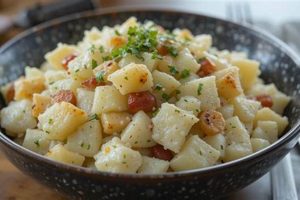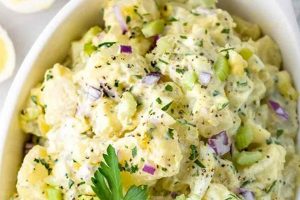A top-tier, simple potato salad involves minimal preparation and cooking time while delivering exceptional flavor. This typically includes readily available ingredients and straightforward methods, making it accessible to cooks of all skill levels. For instance, such a dish might feature boiled potatoes, mayonnaise, mustard, celery, onion, and seasonings, combined without complex procedures or lengthy chilling times.
Effortless preparation and delicious results make a convenient and satisfying dish ideal for potlucks, barbecues, and quick weeknight meals. Historically, potato salad’s simplicity contributed to its popularity as a picnic staple and a common side dish at gatherings. Its adaptable nature allows for variations using different potato types, mayonnaise bases, and added ingredients like hard-boiled eggs or pickles, catering to diverse palates and dietary preferences.
This discussion will explore key elements contributing to a superior, uncomplicated potato salad, including optimal potato choices, dressing variations, ingredient selection, and tips for achieving perfect texture and flavor. Additionally, it will provide practical advice for making this classic dish ahead of time and adapting it to suit individual tastes.
Tips for an Exceptional, Simple Potato Salad
Achieving a delicious and effortless potato salad requires attention to key details. The following tips offer guidance for creating a dish that balances simplicity with exceptional flavor and texture.
Tip 1: Potato Selection: Opt for waxy potatoes, such as red or Yukon Gold, as they hold their shape well after boiling. Avoid starchy potatoes like russets, which tend to become crumbly.
Tip 2: Proper Cooking: Cook potatoes until tender but not mushy. Overcooked potatoes result in a less appealing texture. Start potatoes in cold, salted water to ensure even cooking.
Tip 3: Dressing While Warm: Dress the potatoes while they are still warm. This allows them to absorb the flavors of the dressing more effectively.
Tip 4: Gentle Mixing: Mix the potatoes and other ingredients gently to avoid breaking them apart. A rubber spatula or large spoon works well for this task.
Tip 5: Flavorful Enhancements: Incorporate fresh herbs like dill or chives for added brightness. A touch of Dijon mustard or a splash of vinegar can also elevate the flavor profile.
Tip 6: Balanced Seasoning: Season the salad generously with salt and pepper. Taste and adjust seasonings as needed throughout the preparation process.
Tip 7: Chilling Time: Allow the potato salad to chill for at least 30 minutes before serving. This allows the flavors to meld and the salad to reach an optimal temperature.
By following these tips, one can create a potato salad that is both easy to prepare and satisfyingly delicious. Attention to detail, from potato selection to seasoning, ensures a dish that will impress even the most discerning palates.
These practical guidelines provide a foundation for consistently preparing an excellent, straightforward potato salad. Next, the article will conclude with suggestions for variations and serving options.
1. High-quality Potatoes
Potato quality significantly impacts the final outcome of a simple, yet excellent potato salad. Selecting appropriate potatoes is crucial for achieving desired texture and flavor, ensuring the dish is both easy to prepare and enjoyable to consume. This section explores the facets of high-quality potatoes and their contribution to a superior potato salad.
- Variety
Different potato varieties possess distinct characteristics. Waxy potatoes, such as Yukon Gold or red potatoes, are ideal for potato salad due to their firm texture and ability to hold their shape after boiling. They absorb dressing well without becoming mushy. Conversely, starchy potatoes like russets tend to crumble, resulting in an undesirable texture for potato salad. Choosing the correct variety is foundational to a successful dish.
- Freshness
Fresh potatoes contribute a cleaner, brighter flavor to the salad. Older potatoes may have begun to sprout or soften, negatively affecting both taste and texture. Firm, unblemished potatoes with minimal sprouting indicate freshness and ensure optimal results. Selecting fresh produce enhances the overall quality of the finished dish.
- Proper Storage
Even high-quality potatoes can deteriorate if not stored correctly. Storing potatoes in a cool, dark, and dry environment helps maintain their quality. Avoid storing potatoes in the refrigerator, as this can convert their starches to sugars, affecting their flavor and cooking properties. Proper storage preserves the potatoes’ desirable characteristics for optimal salad preparation.
- Preparation
Careful handling during preparation further contributes to the quality of the potatoes in the salad. Washing potatoes thoroughly removes dirt and debris. Uniformly sized pieces ensure even cooking, preventing some pieces from becoming overcooked while others remain undercooked. Thoughtful preparation enhances the overall texture and presentation of the final dish.
The selection, freshness, storage, and preparation of potatoes significantly influence the overall quality of a simple potato salad. By prioritizing these aspects, one ensures the creation of a dish that is not only easy to make but also delivers exceptional flavor and texture. The right potato contributes significantly to a truly satisfying culinary experience.
2. Efficient Cooking Methods
Efficient cooking methods are integral to a best easy potato salad recipe, impacting both the ease of preparation and the final dish’s quality. Properly cooked potatoes contribute significantly to the desired texture and flavor profile. Inefficient methods can lead to overcooked, mushy potatoes or unevenly cooked pieces, detracting from the overall enjoyment. Conversely, efficient techniques ensure perfectly cooked potatoes while minimizing time and effort.
One example of an efficient cooking method is starting potatoes in cold, salted water and bringing them to a boil. This ensures even cooking throughout. Another efficient technique involves using a steamer basket to cook the potatoes above boiling water. Steaming preserves the potatoes’ nutrients and prevents them from becoming waterlogged, contributing to a firmer, more desirable texture. Furthermore, using the appropriate pot size prevents excessive water usage and reduces cooking time. These practical applications highlight the direct relationship between efficient cooking methods and a superior finished product.
Understanding the importance of efficient cooking methods allows for streamlined preparation and contributes to a higher quality potato salad. Challenges such as overcooked or unevenly cooked potatoes can be easily avoided through the implementation of these techniques. Ultimately, efficient cooking methods are essential for creating a potato salad that is both easy to prepare and delightful to consume, fulfilling the promise of a “best easy” recipe.
3. Flavorful Dressing
Flavorful dressing forms the cornerstone of a best easy potato salad recipe. It provides the unifying element that binds the ingredients and elevates the dish beyond a simple combination of cooked potatoes and vegetables. The dressing’s quality and character directly influence the overall taste experience, transforming a basic preparation into a culinary delight. A bland or unbalanced dressing can render the salad unappetizing, while a well-crafted dressing transforms it into a memorable dish. This cause-and-effect relationship underscores the crucial role of dressing in achieving a truly superlative potato salad.
Consider a classic mayonnaise-based dressing. The richness and tanginess of mayonnaise provide a foundational flavor profile. However, relying solely on mayonnaise can result in a one-dimensional taste. Incorporating elements like Dijon mustard introduces a nuanced complexity, balancing the richness with a subtle sharpness. Adding a splash of apple cider vinegar brightens the flavor and adds a refreshing counterpoint. Fresh herbs, such as dill or chives, contribute an aromatic dimension, while finely chopped pickles or relish introduce a textural and flavor contrast. These examples illustrate how thoughtfully chosen dressing components create a symphony of flavors that elevate the potato salad.
Practical application of this understanding involves careful consideration of flavor balance and ingredient compatibility. Balancing creamy elements with acidic notes, incorporating sweet and savory components, and introducing textural variations all contribute to a more complex and satisfying flavor profile. Understanding these principles allows for informed decisions regarding ingredient selection and proportion, ensuring a flavorful and harmonious dressing. Ultimately, a well-executed dressing transforms a simple potato salad into a culinary achievement, demonstrating the integral connection between flavorful dressing and a “best easy” recipe.
4. Complementary Ingredients
Complementary ingredients play a crucial role in a best easy potato salad recipe, elevating it from simple to exceptional. These additions contribute not only to flavor complexity but also to textural variety and visual appeal. Their presence transforms a basic dish into a multi-sensory experience, impacting the overall enjoyment and satisfaction. The careful selection and incorporation of complementary ingredients demonstrate a thoughtful approach to recipe development, showcasing the difference between a merely adequate potato salad and a truly outstanding one. This cause-and-effect relationship underscores the importance of these supporting components.
Consider the classic additions of celery and red onion. Celery provides a crisp, refreshing counterpoint to the creamy potatoes, introducing a textural contrast. Red onion contributes a pungent bite, balancing the richness of the dressing and adding a vibrant pop of color. Hard-boiled eggs offer a protein element and a creamy texture, enriching the overall composition. Fresh herbs, such as dill or chives, introduce aromatic complexity and a touch of brightness. Even a sprinkle of paprika or a dash of hot sauce can contribute layers of flavor and visual interest. These examples illustrate how thoughtfully chosen complementary ingredients enhance both the culinary and aesthetic aspects of the dish.
Practical application of this understanding requires careful consideration of flavor profiles and textural compatibility. Balancing contrasting elements, such as creamy and crunchy, or sweet and savory, creates a more dynamic and engaging culinary experience. Overcrowding the salad with too many ingredients can dilute the flavors and detract from the simplicity of the dish. A judicious approach to ingredient selection and proportion ensures a harmonious balance, allowing each component to shine while contributing to the overall composition. A well-executed combination of complementary ingredients distinguishes a truly exceptional potato salad, showcasing the critical link between these supporting players and a “best easy” recipe.
5. Proper Chilling Time
Proper chilling time is a critical, often overlooked, component of a best easy potato salad recipe. It directly impacts the final dish’s flavor development and overall quality. Chilling allows the flavors of the various ingredientspotatoes, dressing, and complementary componentsto meld and harmonize. This fusion of flavors elevates the salad from a simple mixture of ingredients to a cohesive, flavorful dish. Insufficient chilling results in a less developed flavor profile, while excessive chilling can negatively affect the texture, particularly of the potatoes. This cause-and-effect relationship underscores the importance of proper chilling as a crucial step in achieving a superlative potato salad.
Consider a potato salad freshly prepared versus one chilled for an appropriate duration. The freshly made salad, while palatable, may present individual flavors that haven’t yet integrated. The potatoes might taste distinct from the dressing, and the other ingredients might stand apart rather than contributing to a unified whole. After proper chilling, typically at least two hours, a noticeable transformation occurs. The flavors meld, creating a harmonious balance. The dressing permeates the potatoes, and the complementary ingredients contribute their nuances to the overall flavor profile. This practical example demonstrates the tangible impact of chilling time on the final product.
Practical application of this understanding involves strategic planning and time management. Recognizing the importance of chilling time allows for appropriate scheduling in the preparation process. Ideally, potato salad should be prepared and chilled several hours before serving, allowing ample time for flavor development. Challenges, such as time constraints, can be addressed by preparing the salad the day before or utilizing quick-chill methods. Ultimately, incorporating proper chilling time ensures the creation of a potato salad that delivers optimal flavor and texture, fulfilling the criteria of a “best easy” recipe. Ignoring this crucial step compromises the final result, diminishing the potential for a truly exceptional dish.
Frequently Asked Questions
This section addresses common inquiries regarding the preparation of a best easy potato salad, offering practical solutions and clarifying potential points of confusion. The information provided aims to enhance understanding and facilitate successful execution of the recipe.
Question 1: What is the best type of potato to use for potato salad?
Waxy potatoes, such as red potatoes or Yukon Golds, are generally preferred for potato salad. These varieties hold their shape well after cooking and absorb dressing effectively without becoming mushy.
Question 2: Can potato salad be made ahead of time?
Potato salad benefits from chilling, allowing the flavors to meld. Preparing it a day or two in advance often enhances the taste. Ensure proper storage in a sealed container in the refrigerator.
Question 3: How long should potatoes be cooked for potato salad?
Potatoes should be cooked until fork-tender but not mushy. The exact cooking time depends on the potato variety and size, but generally ranges from 15 to 25 minutes.
Question 4: What can be added to potato salad besides the standard ingredients?
Numerous ingredients complement potato salad. Consider additions like hard-boiled eggs, bacon, fresh herbs (dill, chives, parsley), pickles, relish, or different types of mustard.
Question 5: How can one prevent potato salad from becoming watery?
Several factors contribute to watery potato salad. Overcooked potatoes release excess moisture. Ensure potatoes are cooked until just tender. Additionally, dress the potatoes while they are still warm, as this facilitates better absorption of the dressing.
Question 6: What are some variations on traditional mayonnaise-based potato salad?
Vinegar-based dressings offer a lighter alternative to mayonnaise. Greek yogurt can be incorporated into the dressing for a tangier flavor and lower fat content. Experimenting with different mustards or adding spices like paprika or celery seed can also create unique flavor profiles.
Understanding these frequently asked questions helps ensure the successful preparation of a high-quality, easy potato salad. Addressing these common concerns allows for a smoother cooking process and enhances the likelihood of a satisfying culinary outcome.
The following section will offer variations on the classic recipe, allowing for customization and exploration of different flavor profiles.
A Best Easy Potato Salad Recipe
This exploration of a best easy potato salad recipe has highlighted the crucial elements contributing to a dish that balances simplicity with exceptional flavor. From the selection of high-quality potatoes and efficient cooking methods to the creation of a flavorful dressing and the incorporation of complementary ingredients, each step plays a vital role in the final outcome. Proper chilling time further enhances the melding of flavors, resulting in a harmonious and satisfying culinary experience. The frequently asked questions section addressed common concerns, providing practical solutions and guidance for achieving optimal results.
Ultimately, a best easy potato salad recipe demonstrates that culinary excellence does not necessitate complexity. Careful attention to detail, thoughtful ingredient selection, and an understanding of fundamental culinary principles allow for the creation of a dish that is both accessible and exceptional. This exploration encourages further experimentation and adaptation, empowering individuals to create their own signature variations on this classic dish, demonstrating the enduring appeal and versatility of the potato salad.






